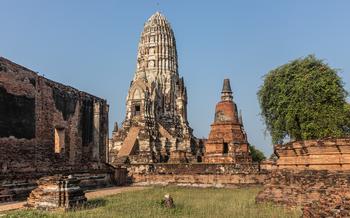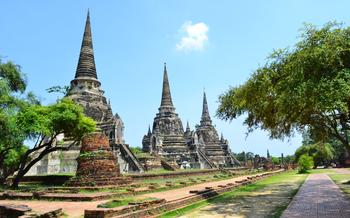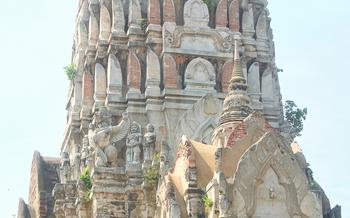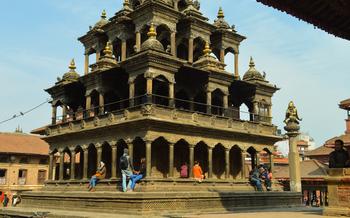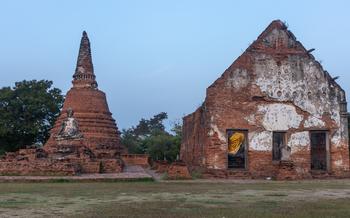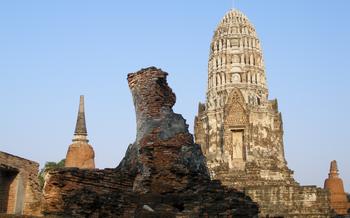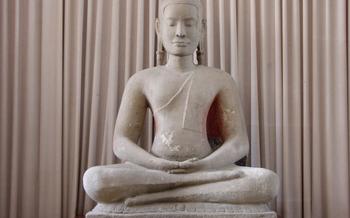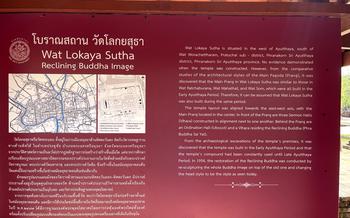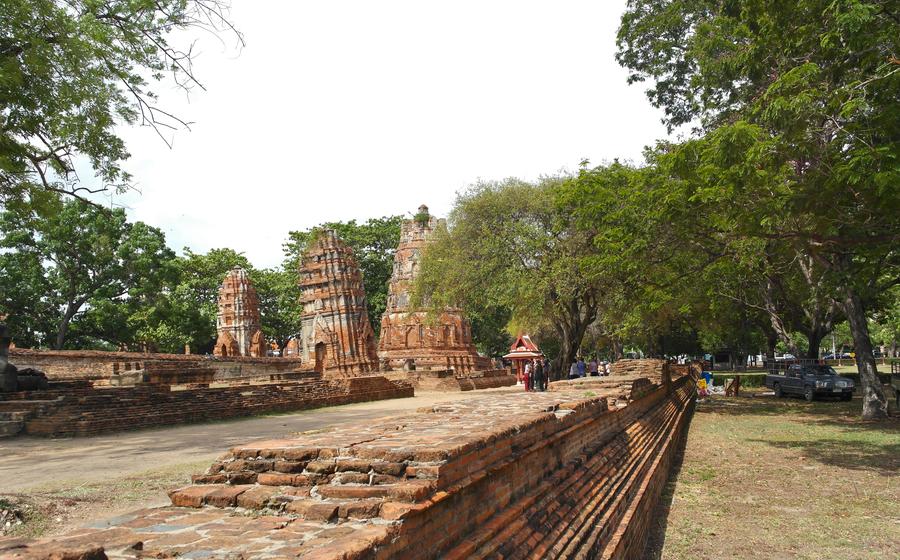
Wat Mahathat
- Historical Significance
- Architectural Marvel
- Buddha Image and Head in the Tree
- Ordination Hall (Ubosot)
- Insider Tip
- Reclining Buddha
- Wihan Phra Mongkhon Bophit
- Surrounding Temples and Ruins
- Best Time to Visit
- Getting There
- Dress Code and Etiquette
- Photography Tips
- Food and Drink Options
- Nearby Attractions
- Insider Tip: Unveiling the Hidden Treasure
Historical Significance
Wat Mahathat is a significant historical and cultural landmark, having served as the religious and administrative center of the ancient Ayutthaya Kingdom. Built in the 14th century, the temple was a testament to the kingdom's grandeur and devotion to Buddhism. Its strategic location on an island formed by the Chao Phraya and Pa Sak rivers made it a vital religious and political hub. Unfortunately, the temple suffered significant destruction during the Burmese invasion of 1767, leaving only ruins and remnants of its former glory. Today, Wat Mahathat stands as a symbol of resilience and a reminder of the rich history of Ayutthaya.
Architectural Marvel
Wat Mahathat showcases a remarkable blend of Khmer and Thai architectural influences that make it a distinctive site. The most prominent feature is the majestic central prang, rising high above the temple grounds. The prang, which symbolizes Mount Meru, the sacred abode of the gods, is adorned with intricate carvings and sculptures depicting celestial beings and mythical creatures.
Other notable architectural features of Wat Mahathat include the wihans (assembly halls) and the stupas. The wihans are large, rectangular buildings with steeply pitched roofs and intricate gable decorations. The interior walls are adorned with vibrant murals and paintings depicting scenes from the life of Buddha and other religious stories.
The stupas are bell-shaped structures that house relics of Buddha or prominent monks. They are scattered throughout the temple grounds, each with its own unique design and symbolism.
The harmonious blend of Khmer and Thai architectural styles at Wat Mahathat creates a truly awe-inspiring sight. The temple's grandeur and intricate details make it a testament to the architectural prowess of the Ayutthaya Kingdom.
Buddha Image and Head in the Tree
One of the most iconic and captivating sights at Wat Mahathat is the Buddha head engulfed by tree roots. This natural phenomenon has become a symbol of the temple and a testament to the enduring power of nature.
The Buddha image, believed to date back to the 16th century, is partially obscured by the roots of a large banyan tree, creating a striking juxtaposition between the ancient artifact and the living tree. The tree's roots envelop the Buddha's head, forming a protective embrace that has preserved the image over centuries.
This natural marvel has given rise to numerous stories and legends. According to one tale, a monk was meditating beneath the tree when he heard a voice instructing him to build a temple around the Buddha image. Another legend tells of a young woman who was searching for her lost lover when she stumbled upon the tree and discovered the Buddha head.
Regardless of their origin, these stories add to the mystique and allure of the Buddha head in the tree. It has become a symbol of hope and resilience, a reminder that even in the face of adversity, beauty and tranquility can prevail.
Ordination Hall (Ubosot)
The Ubosot, also known as the ordination hall, is the central and most sacred building within the Wat Mahathat complex. This grand hall serves as a venue for significant Buddhist ceremonies, including ordinations, chanting rituals, and meditation sessions. Constructed in the classic Ayutthaya architectural style, the Ubosot features a soaring central spire adorned with intricate carvings and ceramic decorations. Its majestic presence exudes an aura of spirituality and tranquility.
The interior walls of the Ubosot are adorned with exquisite murals and paintings that depict scenes from the life of Buddha, Jataka tales, and significant events from Thai history. These vibrant artworks serve as a visual narrative, offering insights into Buddhist teachings and the rich cultural heritage of Thailand. The Ubosot is not only a place of worship but also a repository of artistic treasures, showcasing the exceptional craftsmanship of Ayutthaya artisans.
Insider Tip
Unveiling the Hidden Sanctuary of Wat Mahathat
Venture beyond the main temple complex and discover a hidden sanctuary nestled amidst lush greenery. Follow the path leading to the rear of the temple grounds, where you will find a secluded area with a tranquil pond and a sacred banyan tree. This serene spot offers a respite from the crowds and invites you to immerse yourself in peaceful contemplation.
As you approach the banyan tree, notice the intricate root system that envelops a small Buddha image. This natural phenomenon, where the tree's roots have embraced the Buddha, symbolizes the harmonious coexistence between nature and spirituality. Take a moment to sit beneath the tree, absorb the tranquil atmosphere, and reflect on the impermanence of all things.
This hidden sanctuary is a true gem within Wat Mahathat, offering a unique perspective on the temple's spiritual essence. It is a place where you can connect with your inner self, find solace amidst the bustling temple grounds, and appreciate the beauty of nature's embrace.
Reclining Buddha
Within the sprawling grounds of Wat Mahathat, visitors can find a serene and awe-inspiring sight – a colossal reclining Buddha statue. Known as the Phra Buddha Saiyas, this massive figure exudes an aura of tranquility and spiritual significance. Carved from a single block of sandstone, the reclining Buddha stretches over 42 meters in length and stands as one of the largest and most revered Buddha images in Thailand.
The posture of the reclining Buddha symbolizes the Buddha's entry into parinirvana, the final and ultimate state of enlightenment. With his right hand supporting his head and his left hand resting gracefully on his side, the Buddha appears to be in a state of deep meditation and eternal repose. The serene expression on his face radiates an aura of peace and tranquility, inviting visitors to reflect on the impermanence of life and the pursuit of enlightenment.
The reclining Buddha holds immense cultural and religious significance in Thailand. It represents the Buddha's final teachings and his ultimate release from the cycle of rebirth. Thai Buddhists often visit the reclining Buddha to pay homage and seek blessings, believing that doing so will bring them good fortune and protection. The statue is also a popular destination for meditation and spiritual contemplation, as its serene presence encourages visitors to find inner peace and serenity.
Wihan Phra Mongkhon Bophit
Amidst the ruins stands as a testament to the artistic and religious fervor of the Ayutthaya Kingdom. Constructed in the 16th century, this significant building showcases intricate carvings and sculptures that adorn its exterior and interior.
The wihan, which translates to "abode of the sacred Buddha image," houses a colossal bronze Buddha statue known as Phra Mongkhon Bophit. Standing at an impressive 12 meters tall, the Buddha exudes an aura of serenity and benevolence. The statue's intricate features, including the delicate folds of the robe and the serene expression on the face, reflect the exceptional craftsmanship of Ayutthayan artisans.
The exterior of the wihan is equally captivating, with elaborate carvings depicting scenes from Buddhist mythology and cosmology. Mythical creatures, celestial beings, and human figures intertwine gracefully, creating a harmonious visual symphony. The intricate details and symbolism of these carvings offer a glimpse into the rich spiritual beliefs and artistic traditions of the Ayutthaya period.
The Wihan Phra Mongkhon Bophit serves as a vital center for religious ceremonies and rituals. During significant Buddhist festivals, the wihan comes alive with the chanting of monks and the devotion of worshippers. The sacred atmosphere and spiritual energy that permeate the space create a profound sense of connection to the divine.
Exploring the Wihan Phra Mongkhon Bophit is a journey through history, art, and spirituality. This remarkable building stands as a testament to the enduring legacy of the Ayutthaya Kingdom and invites visitors to immerse themselves in the beauty and sacredness of Thai Buddhist culture.
Surrounding Temples and Ruins
Wat Mahathat is surrounded by a cluster of ancient temples and ruins, each holding its own historical significance. To the north lies Wat Ratchaburana, renowned for its intricate stucco decorations and well-preserved murals depicting scenes from Thai mythology. Wat Phra Si Sanphet, once the grandest temple in the Ayutthaya Kingdom, now stands in ruins, showcasing the grandeur of its past. To the west, visitors can explore Wat Lokaya Sutha, featuring a large reclining Buddha statue and a unique blend of architectural styles.
For a comprehensive historical experience, consider joining a guided tour that covers multiple temples and ruins in the area. These tours often provide insightful commentary and allow visitors to explore hidden corners and lesser-known sites. Itineraries can be customized to suit different interests and time constraints, ensuring a fulfilling and educational journey through Ayutthaya's rich cultural heritage.
Best Time to Visit
Visiting Wat Mahathat at the right time can greatly enhance your experience. The best time to visit is during the dry season, which typically runs from November to April. During this time, the weather is pleasant, with warm and sunny days, making it ideal for exploring the temple complex and its surroundings. The skies are generally clear, providing excellent conditions for photography.
As for the time of day, early morning or late afternoon is recommended. The soft, golden light during these hours creates a magical atmosphere and allows for stunning photographs. Additionally, the temperature is more comfortable, making it more enjoyable to walk around the temple grounds.
To avoid crowds, it's best to visit during weekdays rather than weekends or public holidays. If possible, try to arrive at the temple early in the morning before the tour groups arrive. This will give you the opportunity to explore the complex at your own pace and capture some peaceful shots without the crowds.
Remember to plan your visit accordingly, taking into account the weather conditions, time of day, and crowd levels to make the most of your experience at Wat Mahathat.
Getting There
Reaching Wat Mahathat is a breeze from Bangkok, Thailand's bustling capital city, and other major destinations within the country. For a seamless journey, consider these transportation options:
Public Transportation: Embrace the local experience by hopping on a public bus or van from Bangkok's Northern Bus Terminal (Mo Chit). The ride takes approximately 1 hour and 30 minutes, and tickets cost around 100-150 THB.
Taxis: Taxis offer a convenient and direct route to Wat Mahathat. From Bangkok, the fare typically ranges from 1,500 to 2,000 THB for a one-way trip. Negotiate a price before your journey to avoid surprises.
Private Tours: For a hassle-free and enriching experience, opt for a private tour from Bangkok or nearby cities. These tours often include transportation, a knowledgeable guide, and additional stops at other attractions. Prices vary depending on the tour operator and itinerary.
Once in Ayutthaya, tuk-tuks and songthaew (shared taxis) are readily available to take you to Wat Mahathat and other historical sites within the city. The fare for a tuk-tuk ride within the city center typically ranges from 50 to 100 THB.
Parking: Wat Mahathat provides ample parking space for visitors arriving by car or motorbike. The parking lot is located near the temple entrance, and a small fee may be charged.
Dress Code and Etiquette
When visiting Wat Mahathat and other Buddhist temples in Thailand, it is essential to dress modestly and respectfully. Avoid wearing shorts, tank tops, or revealing clothing that might be considered disrespectful. Instead, opt for long pants or skirts that cover your knees and shoulders. It's also customary to remove your shoes before entering the temple grounds and carry them in a bag or basket provided.
Be mindful of your behavior within the temple complex. Speak softly, avoid loud noises, and refrain from running or playing. When encountering monks, greet them with a respectful "wai" (a traditional Thai greeting involving placing your hands together in a prayer-like gesture and bowing slightly) and avoid touching them or their robes.
Remember that temples are sacred places of worship for Buddhists, so it's important to show respect and consideration for their beliefs and practices. By observing proper dress code and etiquette, you can help preserve the sanctity of these religious sites and contribute to a harmonious and enjoyable experience for all visitors.
Photography Tips
Capturing the essence of Wat Mahathat through photography requires careful consideration of angles, lighting, and composition. For breathtaking shots of the temple's iconic prangs, position yourself at a low angle to create a sense of grandeur. Utilize natural light to your advantage, avoiding harsh midday sun that can result in overexposed images. Experiment with different perspectives by exploring the temple grounds, discovering hidden corners, and capturing unique details that often go unnoticed. The Buddha image engulfed by tree roots presents a compelling subject for photography. Frame the image to showcase the harmonious coexistence between nature and spirituality. Patience is key when photographing Wat Mahathat. Take your time to observe the temple's intricate details, waiting for the perfect moment when the light falls just right, casting dramatic shadows and illuminating the temple's grandeur.
Food and Drink Options
Wat Mahathat offers a range of food and beverage options to cater to the needs of visitors. Within the temple complex, you'll find several small stalls and vendors selling a variety of Thai snacks, drinks, and souvenirs. These stalls offer a glimpse into local cuisine and provide a convenient way to grab a quick bite or refreshment while exploring the temple grounds.
For a more substantial meal, you can venture outside the temple complex and explore the surrounding area. Ayutthaya is renowned for its delicious local dishes, including boat noodles, grilled river prawns, and mango sticky rice. Many restaurants and cafes are located within walking distance of the temple, offering a diverse range of culinary options.
For a truly authentic experience, try the local street food. Ayutthaya's night market is a popular spot to sample a variety of Thai delicacies, including grilled meats, noodle dishes, and sweet treats. The market is a vibrant and lively place, offering a unique opportunity to immerse yourself in the local culture while satisfying your taste buds.
Whether you're looking for a quick snack or a memorable dining experience, Ayutthaya has something to offer every visitor. Be sure to sample the local cuisine and soak in the vibrant culinary scene that surrounds Wat Mahathat.
Nearby Attractions
In the vicinity of Wat Mahathat, a trove of historical and cultural attractions awaits exploration. Among them, the Wat Phra Si Sanphet stands out as a must-visit destination. This magnificent temple complex was once the grandest in Ayutthaya, serving as the royal temple of the Ayutthaya Kingdom. Its three towering chedis, adorned with intricate carvings, are a testament to the kingdom's architectural prowess.
Another notable attraction is the Chao Sam Phraya National Museum. Housed in a former palace, the museum showcases a vast collection of artifacts and exhibits that narrate the captivating history of Ayutthaya. From ancient pottery and sculptures to royal regalia and weaponry, the museum offers a glimpse into the kingdom's glorious past.
For those seeking a unique experience, a visit to the Ayutthaya Floating Market is a must. This vibrant market, situated along the Ayutthaya River, offers a delightful blend of traditional Thai culture and commerce. Visitors can browse colorful stalls selling local handicrafts, savor delicious Thai cuisine, and witness the bustling river life that has characterized Ayutthaya for centuries.
These attractions, along with many others, form a tapestry of historical and cultural experiences that complement a visit to Wat Mahathat. Whether you're a history buff, a culture enthusiast, or simply seeking a glimpse into Thailand's rich heritage, the surrounding area offers an abundance of opportunities for exploration and discovery.
Insider Tip: Unveiling the Hidden Treasure
Beyond the well-trodden paths of Wat Mahathat, a hidden gem awaits those who venture off the beaten track. Tucked away in a secluded corner of the temple complex, shrouded by lush foliage, lies a serene pond known as "Bua Kham" or the "Pink Lotus Pond."
To reach this tranquil oasis, take a moment to explore the lesser-known ruins and temples scattered throughout the grounds. Follow the winding paths, and as you approach the pond, the air becomes still, inviting a sense of peace and tranquility.
The pond's tranquil waters are adorned with delicate pink lotus blossoms, creating a picturesque sight that will captivate your senses. Take a moment to sit by the pond's edge, soak in the tranquility, and let the beauty of the natural surroundings transport you to a realm of serenity.
This hidden gem is a testament to the temple's rich history and offers a unique perspective on the beauty and tranquility that Wat Mahathat holds. Whether you seek a moment of contemplation or simply a respite from the bustling crowds, the Pink Lotus Pond awaits with its enchanting charm, inviting you to discover the hidden treasures that lie within this ancient temple complex.
